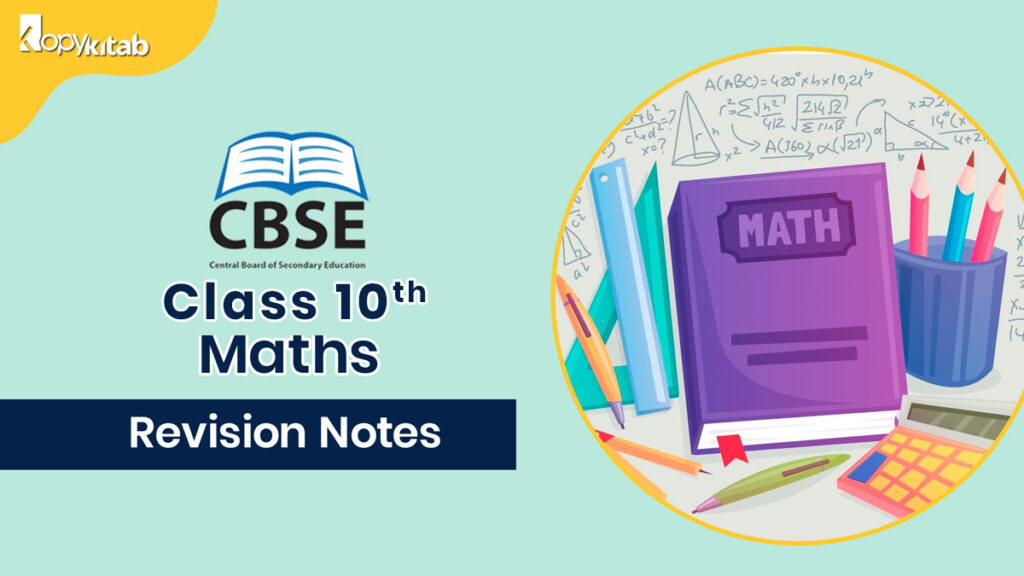CBSE Class 10 Maths Toppers Notes
Chapter Wise CBSE Quick Revision Notes and Key Points for Class 10 Maths Pdf free download was designed by expert teachers at https://cbsejeeneet.com/ from latest edition of NCERT books to get good marks in board exams. NCERT Class 10 Maths Notes contains all chapters are part of Revision Notes for Class 10. Here we have given CBSE Maths Notes for Class 10. According to new CBSE Exam Pattern, MCQ Questions for Class 10 Maths Carries 20 Marks.
CBSE Notes for Class 10 Maths

- Chapter 1 Real Numbers Class 10 Notes
- Chapter 2 Polynomials Class 10 Notes
- Chapter 3 Pair of Linear equations in Two Variables Class 10 Notes
- Chapter 4 Quadratic Equations Class 10 Notes
- Chapter 5 Arithmetic Progressions Class 10 Notes
- Chapter 6 Triangles Class 10 Notes
- Chapter 7 Coordinate Geometry Class 10 Notes
- Chapter 8 Introduction to Trigonometry Class 10 Notes
- Chapter 9 Some Applications of Trigonometry Class 10 Notes
- Chapter 10 Circles Class 10 Notes
- Chapter 11 Constructions Class 10 Notes
- Chapter 12 Areas related to Circles Class 10 Notes
- Chapter 13 Surface Areas and Volumes Class 10 Notes
- Chapter 14 Statistics Class 10 Notes
- Chapter 15 Probability Class 10 Notes
We hope the given Chapter Wise CBSE Quick Revision Notes and Key Points for Class 10 Maths Pdf free download of physics, chemistry and biology notes will help you. If you have any query regarding NCERT Class 10 Maths Notes, drop a comment below and we will get back to you at the earliest.
The CBSE Class 10 Mathematics exam usually consists of both theory and practical components. The theory part involves answering questions based on the topics mentioned earlier, while the practical component may include activities related to constructions, graphical representations, and problem-solving.
- Real Numbers: Properties of rational and irrational numbers, Euclid’s division lemma, and the fundamental theorem of arithmetic.
- Polynomials: Study of quadratic equations, relationship between roots and coefficients, factorization, and long division of polynomials.
- Pair of Linear Equations in Two Variables: Solving linear equations in two variables using graphical and algebraic methods.
- Triangles: Properties of triangles, congruence, similarity, and the Pythagoras theorem.
- Trigonometry: Introduction to trigonometric ratios, trigonometric identities, and solving problems involving heights and distances.
- Coordinate Geometry: Understanding the concept of Cartesian coordinates and plotting points in the coordinate plane.
- Introduction to Trigonometry: Introduction to trigonometric ratios and solving problems involving heights and distances.
- Quadratic Equations: Solving quadratic equations using different methods such as factorization and the quadratic formula.
- Arithmetic Progressions: Studying arithmetic sequences and finding the nth term and sum of the first n terms.
- Circles: Understanding properties of circles, tangents, and chords.
- Constructions: Construction of different geometrical shapes using a compass and ruler.
- Areas Related to Circles: Calculation of the area of a circle, sector, and segment.
- Surface Areas and Volumes: Finding the surface area and volume of different 3D shapes like cubes, spheres, cylinders, and cones.
- Statistics: Understanding concepts of mean, median, mode, and constructing graphs.
- Probability: Introduction to probability and solving probability-based problems.
![[PDF] Science Term 2 Chapterwise Previous Year Question | CBSE CLASS 10 | CBSE JEE NEET](https://cbsejeeneet.com/wp-content/uploads/2022/03/1646302594152879-0.jpg)
![[PDF] DOWNLOAD SST BOOKLETS OF SHOBHIT NIRWAN CLASS 10 | CBSE CLASS 10 | CBSE JEE NEET](https://cbsejeeneet.com/wp-content/uploads/2022/03/1646547052320384-0.jpg)
![[PDF] Arihant Term 2 Sample Papers for Class 10 Download | CBSE Class 10 | CBSE JEE NEET](https://cbsejeeneet.com/wp-content/uploads/2022/03/1647793555208564-0.jpg)
![[PDF] Super 20 Sample Papers Class 10 Term 2 | CBSE Class 10 | CBSE JEE NEET](https://cbsejeeneet.com/wp-content/uploads/2022/03/1647794818176566-0.jpg)
![[Pdf] Download Class 10 Bkp Science, Social Science And Maths Cheat Sheet – By Bhai Ki Padhai – CBSE JEE NEET](https://cbsejeeneet.com/wp-content/uploads/2022/03/1647850138936063-0.jpg)
![[PDF] Arihant CBSE Term 2 Question Banks for Class 10 Download | CBSE Class 10 | CBSE JEE NEET](https://cbsejeeneet.com/wp-content/uploads/2022/03/1647876516088896-0.jpg)